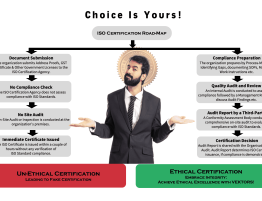
Important Facts:
- ISO which stands for ‘International Organization for Standardization’, DOES NOT issue ISO Certificates.
- ISO does not play any role in the certification process against the standards, developed & published by ISO itself.
- Most of the published ISO Standards are developed to help organizations to establish management system for doing the Better Business, to move towards Business Excellence, enhance Customer’s Satisfaction, enhance Efficiency & Productivity leading to Higher Profitability.
- Therefore alternatively, an organization can choose to implement an ISO standard without opting for certification, to reap the benefits of Business Excellence. It is NOT Mandatory for an organization to proceed for certification post implementation of the ISO standard.
However, ISO does recommend organizations seeking certification to choose a credible, recognized & accredited Certification Body or Conformity Assessment Body, if certification is required.
How to get ISO Certified?
A few implementation tips:
Tip 1 – Define your objectives. Why do you want to implement the standard?
Tip 2 – Make sure senior management is on board. It is crucial that everyone – from the top down – is supportive of the initiative and its objectives.
Tip 3 – Identify your organization’s key processes for meeting your objectives as well as your customers’ needs. Within each of these processes, make sure you understand our customers’ requirements and can guarantee that these are met – each and every time. This will form the basis of your quality management system.
Step 1: Selection of the right consultant or consulting firm
Choose the right consultant who can help you demystify the ISO standard, simplify the implementation and focuses more on effectiveness of the management system rather than documentation only.
Step 2: Implementation of the ISO Standard (A Management System)
The selected consultant shall help the organization towards implementation of the management system in compliance to the ISO Standard. The implementation duration may vary and shall depend on the level of participation between the consultant and the organization seeking to implement the ISO standard. Let’s take a case of ISO 9001:2015. The implementation procedure may take various steps including Gap Analysis, Process Mapping, Understanding the organization and its context, Discussions & Brainstorming sessions to identify & evaluate the process control parameters, documentation, internal audits etc.
He should help close all non-conformities and should assess the effectiveness of the established management system. On successful assessment, the consultant, recommends the organization to invite the selected Certification Body (Conformity Assessment Body) for the assessment, if the organization opts for third party endorsement through certification.
Step 3: Selection of Conformity Assessment Body (C.A.B.) or Certification Body
The ISO certification audit is not a financial audit. No certification is done ethically, without the implementation of the ISO standard. The audit performed by the Certification Body is against the implemented ISO standard.
You can search a Credible, Recognized & Accredited Certification Body by visiting the link. This page list out the Accreditation Boards and you can select the suitable one to choose an accredited Certification Body. A Credible, Recognized & Accredited Certification Body shall never offer consulting services owing to breach of impartiality agreement with the Accreditation Boards.
Step 4: Issuance of the ISO Certificate
The ISO Certificate is issued against the compliance of the ISO Standard observed during the audit performed by the certification body. If there are certain major non-conformities observed during the audit, they should be closed before the award of the ISO Certificate. In case of absence of any such major non-conformities, the ISO Certificate shall be awarded to the aspiring organization.
Know more? What is the procedure for ISO Certification?
Know more? What are the documents required for ISO Certification?



